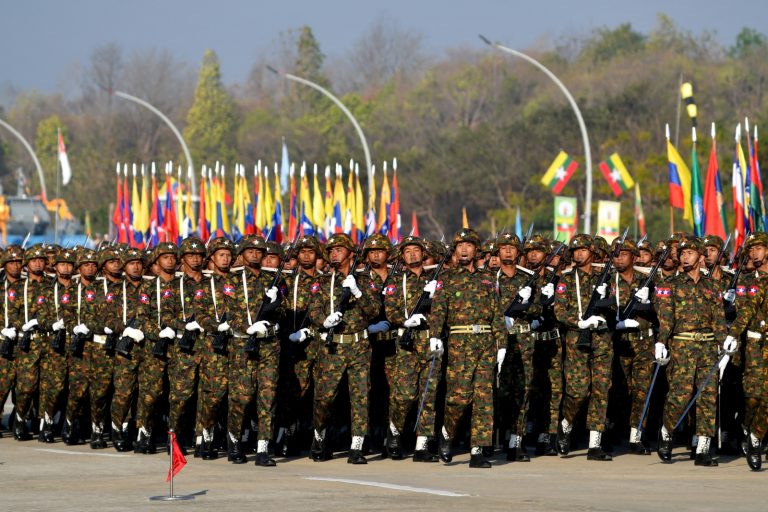By SEAN GLEESON | FRONTIER
YANGON — Amid renewed military offensives, and with the latest national peace talks ending in deadlock, a new report on the eve of the Kachin conflict’s anniversary has highlighted the toll six years of violence and displacement has taken on civilian women in Kachin State.
Based on discussions with women living in displacement camps across the state, the Life on Hold report highlights the ongoing humanitarian crisis facing some of the country’s most vulnerable people.
Nearly all the women interviewed said they had either experienced or witnessed sexual assault, forced labour, arbitrary detention or torture at the hands of the military, pro-government militias or non-state armed groups during the conflict.
Elsewhere, the report’s participants recounted the ongoing misery of living in makeshift camps, describing widespread incidence of domestic violence and rape, insufficient healthcare and sanitation facilities, inadequate access to education for displaced youth, and discrimination from communities hosting those who fled their homes in the conflict.
Support more independent journalism like this. Sign up to be a Frontier member.
Since the collapse of a 17-year ceasefire between the government and the Kachin Independence Organisation in June 2011, more than 130,000 people have been displaced by clashes in Myanmar’s north.
At least 87,000 people remain in internally displaced persons camps in Kachin State, of whom more than three quarters are women.
Nearly half of the people in IDP camps live in areas under KIO control and are subject to a blanket government restriction on humanitarian aid inflows.
The report, published by Irish aid agency Trocaire with the support of several partner groups also operating in Kachin State, paints a bleak picture of daily life for women in the camps, many of whom continue to struggle with the trauma of losing loved ones and leaving behind their homes.
“I had lost my home, the livestock, all utensils, my clothes and other things. I could not take anything with me and I do not feel safe,” one of the report’s interviewees told Trocaire. “I am weak and I have started to be sick very often. We are poor in terms of food and shelter, clothing and we are very worried. Our lives are lost.”
Renewed conflict
Last year saw some of the fiercest fighting in Kachin State since the military’s 2013 bombardment of the KIO headquarters at Laiza, on the Chinese border.
In the weeks prior to the government’s 21st Century Panglong conference last Auguest, the first top level peace summit since the National League for Democracy government took office earlier that year, the military commenced a fresh offensive on the Kachin Independence Army’s strategic positions.
Months of clashes culminated with a KIA retreat from two hill posts near Laiza, raising fears the military would press ahead to the KIO headquarters in the next year.
Thousands of civilians already living in IDP camps were displaced by the clashes, leading to acute shortages of food and healthcare.
Speaking to Frontier in January, senior KIO official General Gun Maw said he believed the military had devised a plan to secure a military victory over the group in the next three years.
He expressed disappointment that the government had refused to allow a Kachin delegation to fully participate in the first peace conference while it remained outside of the so-called Nationwide Ceasefire Agreement concluded by the U Thein Sein administration in 2015.
“Instead of giving us answers or replies on these issues they are using military force, extensive offensives, and pressure is being applied,” he said.
The KIO has since announced its intention to withdraw from the United Nationalities Federal Council, a key negotiating bloc of which it was a senior member, and aligned itself with a new coalition of armed groups calling for a rejection and renegotiation of the NCA — a platform stridently opposed by military chief Senior General Min Aung Hlaing.
State Counsellor Daw Aung San Suu Kyi met with KIO leaders on the sidelines of last month’s Panglong peace conference, but those present said no substantial matters on the peace process were discussed.
Meanwhile, clashes between the military and KIO have resumed in recent weeks.
On Monday, the military initiated a letter-drop campaign in several villages near Tanai, 150 kilometres northwest of Myitkyina, ordering the 3,000 civilians in the area to vacate prior to June 15.
Clashes broke out two days later between the KIA and the military, which has blockaded a number of roads leading out from the villages to Tanai.
Speaking at the Yangon launch of the Life on Hold report Thursday, Gun Mai, a project manager with the Shalom Foundation, expressed sadness that the conflict appeared to be gathering pace in Kachin once again.
“Every year we wish and pray this will be the last year of fighting,” he said. “During the last three months the armed conflict seemed to be decreasing. But now it is increasing again.”
Gun Mai added that dissatisfaction with the peace process was understandable given that that recent national level peace conferences had coincided with heightened fighting in Kachin State.
“We have come to conclude this is not at all a coincidence.”
TOP PHOTO: Chyahkyi Hkawn Bu, with her 20 month old daughter, both residents of Mung Lai Hkyet IDP camp. Their community was shelled by the military early on the morning of December 18 last year, in the middle of weeks of clashes during an assault on KIA hill posts near Laiza. (Steve Tickner | Frontier)







